Peace symbols

A number ofpeace symbolshave been used many ways in various cultures and contexts. Thedoveandolive branchwas used symbolically by early Christians and then eventually became a secular peace symbol, popularized by aDovelithographbyPablo Picassoafter World War II. In the 1950s, the "peace sign", as it is known today (also known as "peace and love" ), was designed byGerald Holtomas the logo for the BritishCampaign for Nuclear Disarmament(CND),[1]a group at the forefront of thepeace movementin the UK, and adopted by anti-war andcountercultureactivists in the US and elsewhere. The symbol is asuperpositionof thesemaphoresignals for the letters "N" and "D", taken to stand for "nuclear disarmament",[2]while simultaneously acting as a reference toGoya'sThe Third of May 1808(1814) (aka "Peasant Before the Firing Squad" ).[3]
TheV hand signaland thepeace flagalso became international peace symbols.
Olive branch
[edit]Classical antiquity
[edit]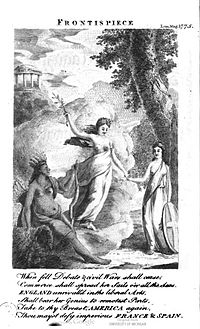
The use of the olive branch as a symbol of peace in Western civilization dates at least to 5th century BC Greece. The olive branch, which the Greeks believed represented plenty and drove away evil spirits,[4]was one of the attributes ofEirene,[5]the Greek goddess of peace. Eirene (whom the Romans calledPax), appeared on Roman Imperial coins[6]with an olive branch.
TheRomanpoetVirgil(70–10 BC) associated "the plump olive"[7]with Pax and he used the olive branch as a symbol of peace in hisAeneid:[8]
High on the stern Aeneas his stand,
And held a branch of olive in his hand,
While thus he spoke: "The Phrygians' arms you see,
Expelled from Troy, provoked in Italy
By Latian foes, with war unjustly made;
At first affianced, and at last betrayed.
This message bear: The Trojans and their chief
Bring holy peace, and beg the king's relief. "
The Romans believed there was an intimate relationship between war and peace.Mars,the god of war, had another aspect, Mars Pacifer, Mars the bringer of Peace, who is shown on coins of the later Roman Empire bearing an olive branch.[9][10]Appiandescribes the use of the olive-branch as a gesture of peace by the enemies of the Roman generalScipio Aemilianusin theNumantine War[11]and byHasdrubalofCarthage.[12]
Later representations
[edit]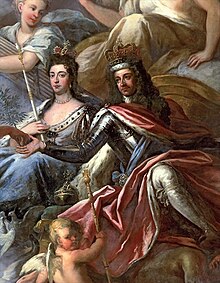
Poets of the 17th century associated the olive branch with peace.[13]ACharles Igold coin of 1644 shows the monarch with sword and olive branch.[14]Throughout the 18th century, English coins showBritanniawith a spear and olive branch.
TheOld Royal Naval College,Greenwich,contains an allegorical painting byJames Thornhill,Peace and Liberty Triumphing Over Tyranny(1708–1716), depictingKing William IIIandQueen Mary(who had enacted theEnglish Bill of Rights) enthroned in heaven with the Virtues behind them. Peace, with her doves and lambs, hands an olive branch to William, who in turn hands the cap of liberty to Europe, whereabsolute monarchyprevails. Below William is the defeated French king,Louis XIV.[15]
In January 1775, the frontispiece of theLondon Magazinepublished an engraving of Peace descending on a cloud from the Temple of Commerce, bringing an olive branch to America and Britannia. In July that year, the AmericanContinental Congressadopted the "Olive Branch Petition"in the hope of avoiding a full-blown war with Great Britain.[8]
On theGreat Seal of the United States(1782), the olive branch denotes peace, as explained byCharles Thomson,Secretary to Congress: "The Olive branch and arrows denote the power of peace & war which is exclusively vested in Congress."[8]
Dove and olive branch
[edit]Christianity
[edit]
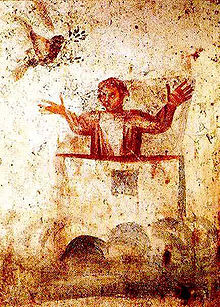

The use of adove as a symbol of peaceoriginated withearly Christians,who portrayedbaptismaccompanied by a dove, often on theirsepulchres.[10][16]
TheNew Testamentcompared the dove to theSpirit of Godthat descended on Jesus duringhis baptism.[17][18]Christians saw similarities between baptism and Noah's Flood. TheFirst Epistle of Peter(composed around the end of the first century AD[19]) said that the Flood, which brought salvation through water, prefigured baptism.[20]Tertullian(c. 160– c. 220) compared the dove, who "announced to the world the assuagement of divine wrath, when she had been sent out of the ark and returned with the olive branch, to the Holy Spirit who descends in baptism in the form of a dove that brings the peace of God, sent out from the heavens".[21]
At first the dove represented the subjective personal experience of peace, the peace of the soul, and in the earliest Christian art it accompanies representations of baptism. By the end of the second century (for example in the writing of Tertullian)[22]it also represented social and political peace, "peace unto the nations", and from the third century it began to appear in depictions of conflict, such as Noah and the Ark,Danieland the lions, thethree young men in the furnace,andSusannah and the Elders.[23][24]
The dove appears in Christian inscriptions in theRoman catacombs,sometimes accompanied by the wordsin pace(Latin for "in peace" ). For example, in theCatacomb of Callixtus,a dove and branch are drawn next to a Latin inscription NICELLA VIRCO DEI OVE VI XIT ANNOS P M XXXV DE POSITA XV KAL MAIAS BENE MERENTI IN PACE, meaning "Nicella, God's virgin, who lived for more or less 35 years. She was placed [here] 15 days before the Kalends of May [17 April]. For the well deserving one in peace."[25]In another example, a shallow relief sculpture shows a dove with a branch flying to a figure marked in Greek asΕΙΡΗΝΗ(Eirene, or Peace).[26]The symbol has also been found in the Christian catacombs ofSousse,Tunisia (ancientCarthage), which date from the end of the first century AD.[27][28][29]
The Christian symbolism of the olive branch, invariably carried by the dove, derives from Greek usage and the story of Noah in the Hebrew Bible.[30]The story of Noah ends with a dove bringing a freshly plucked olive leaf (Hebrew: עלה זיתalay zayit),[31]a sign of life after the Flood and of God's bringing Noah, his family and the animals to land.Rabbinicliterature interpreted the olive leaf as "the young shoots of the Land of Israel"[32]or the dove's preference for bitter food in God's service, rather than sweet food in the service of men.[33][34][35]and neither represented peace in Jewish thought, but the dove and olive branch acquired that meaning in Christianity.[36]
Before thePeace of Constantine(313 AD), in which Rome ceased its persecution of Christians following Constantine's conversion, Noah was normally shown in anattitude of prayer,a dove flying toward him or alighting on his outstretched hand. According to Graydon Snyder, "The Noah story afforded the early Christian community an opportunity to express piety and peace in a vessel that withstood the threatening environment" of Roman persecution.[23]According to Ludwig Budde and Pierre Prigent, the dove referred to the descending of the Holy Spirit rather than the peace associated with Noah. After the Peace of Constantine, when persecution ceased, Noah appeared less frequently in Christian art.[23]
In the fourth century,St. Jerome'sLatin Bibletranslated the Hebrew "alay zayit"in the Noah story as"ramum olivae",(" olive branch "), possibly reflecting the Christian equivalence between the peace brought by baptism and peace brought by the ending of the Flood. By the fifth century, St Augustine confirmed the Christian adoption of the olive branch as a symbol of peace, writing that," perpetual peace is indicated by the olive branch (Latin:oleae ramusculo) that the dove brought with it when it returned to the ark. "[37]
Medievalilluminated manuscripts,such as theHolkhamBible, showed the dove returning to Noah with a branch.[38]Wycliffe's Bible,which translated the Vulgate into English in the 14th century, uses "a braunche of olyue tre with greene leeuys" ( "a branch of olive tree with green leaves" ) in Gen. 8:11.[39]In the Middle Ages, some Jewish manuscripts, which were often illustrated by Christians,[40]also showed Noah's dove with an olive branch, for example, the GoldenHaggadah(about 1420).[41][42]
English Bibles from the 17th-centuryKing James Bibleonwards, which translated the story of Noah direct from Hebrew, render the Hebrew 'aleh zayitas "olive leaf" rather than "olive branch", but by this time the association of the dove with an olive branch as a symbol of peace in the story of Noah was firmly established.[citation needed]
Secular representations
[edit]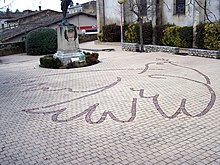
- Late 15th centuryIn the late 15th century, a dove with an olive branch was used on the seal ofDieci di Balia,theFlorentinecommittee known as The Ten of Liberty and Peace,[43]whose secretary wasMachiavelli;it bore the motto, "Pax et Defencio Libertatis" (Peace and the Defence of Liberty).[44]
- Late 18th centuryIn 18th century America, a £2 note of North Carolina (1771) depicted the dove and olive with a motto meaning: "Peace restored". Georgia's $40 note of 1778 portrayed the dove and olive and a hand holding a dagger, with a motto meaning "Either war or peace, prepared for both."[8]
- Early 19th centuryThe Society for the Promotion of Permanent and Universal Peace, also known as The London Peace Society, formed on aQuakerinitiative in 1816, used the symbol of a dove and olive branch.[45]
- Early 20th centuryA German war loan poster of 1917 showed the head of an eagle over a dove of peace in flight, with the text, "Subscribe to the War Loan".[citation needed]
- Mid 20th centuryPicasso's lithograph,La Colombe(The Dove), a traditional, realistic picture of a pigeon, without an olive branch, was chosen as the emblem for theWorld Peace Councilin Paris in April 1949.[46]The dove became a symbol for the peace movement and the ideals of theCommunist Partyand was used in Communist demonstrations of the period. At the 1950 World Peace Council inSheffield,Picasso said that his father had taught him to paint doves, concluding, "I stand for life against death; I stand for peace against war."[47][48]At the 1952 World Peace Council in Berlin, Picasso'sDovewas depicted in a banner above the stage. The dove symbol was used extensively in the post-warpeace movement.[citation needed]Anti-communistshad their own take on the peace dove: the groupPaix et Libertédistributed posters titledLa colombe qui fait BOUM(the dove that goes BOOM), showing the peace dove metamorphosing into aSoviettank.[49]
Broken rifle
[edit]
The broken rifle symbol is used byWar Resisters' International(WRI) and its affiliates but predates the foundation of WRI in 1921. The first known example of the symbol is in the masthead of the January 1909 issue ofDe Wapens Neder(Down with Weapons), the monthly paper of the International Antimilitarist Union in the Netherlands. In 1915 it appeared on the cover of a pamphlet,Under det brukne Gevær(Under the Broken Rifle), published by theNorwegian Social Democratic Youth Association.The (German) League for War Victims, founded in 1917, used the broken rifle on a 1919 banner.[citation needed]
In 1921, Belgian workers marching through La Louvrière on 16 October 1921, carried flags showing a soldier breaking his rifle.Ernst Friedrich,a German who had refused military service, founded the Anti-Kriegs Museum in Berlin, which featured a bas-relief broken rifle over the door. The Museum distributed broken-rifle badges, girls' and women's brooches, boys' belt buckles, and men's tie pins.[50]
White poppy
[edit]In 1933, during a period in which there was widespread fear of war in Europe, theWomen's Co-operative Guildbegan the practice of distributingwhite poppies[51]as an alternative to the red poppies distributed by theRoyal British Legionin commemoration of servicemen who died in the First World War.[51]In 1934 the newly formedPeace Pledge Union(PPU), which was the largest British peace organization in the inter-war years, joined in distributing white poppies and laying white poppy wreaths "as a pledge to peace that war must not happen again". In 1980, the PPU revived the symbol as a way of remembering the victims of war without glorifying militarism.[citation needed]
Roerich's peace banner
[edit]
Nicholas Roerich(1874–1947), a Russian artist, cultural activist, and philosopher, founded a movement to protect cultural artifacts. Its symbol was a maroon-on-white emblem consisting of three solid circles in a surrounding circle. It has also been used as a peace banner. In 1935 a pact initiated by Roerich was signed by the United States and Latin American nations, agreeing that "historic monuments, museums, scientific, artistic, educational and cultural institutions" should be protected both in times of peace and war.
According to the Roerich Museum,
The Banner of Peace symbol has ancient origins. Perhaps its earliest known example appears on Stone Age amulets: three dots, without the enclosing circle. Roerich came across numerous later examples in various parts of the world, and knew that it represented a deep and sophisticated understanding of thetriunenature of existence. But for the purposes of the Banner and the Pact, Roerich described the circle as representing the totality of culture, with the three dots being Art, Science, and Religion, three of the most embracing of human cultural activities. He also described the circle as representing the eternity of time, encompassing the past, present, and future. The sacred origins of the symbol, as an illustration of the trinities fundamental to all religions, remain central to the meaning of the Pact and the Banner today.[52]
Peace symbol
[edit]| ☮ | |
|---|---|
Peace symbol | |
| InUnicode | U+262E☮PEACE SYMBOL |
| Different from | |
| Different from | Mercedes-Benzlogo |
| Related | |
| See also | U+1F54A🕊DOVE OF PEACE U+270C✌VICTORY HAND |
The symbol now known internationally as the "peace symbol" or "peace sign", was created in 1958 as a symbol for Britain's campaign fornuclear disarmament.[53]It went on to be widely adopted in the Americananti-war movementin the 1960s and was re-interpreted as generically representingworld peace.It was also used by activistsopposing nuclear powerin the 1980s,[citation needed]although theSmiling Sunimage (![]() ) [ "Nuclear power? No thanks!]" predominated.
) [ "Nuclear power? No thanks!]" predominated.
Origin
[edit]The symbol was designed byGerald Holtom(1914–1985), who presented it toDirect Action Committeeon 21 February 1958.[1]It was "immediately accepted" as a symbol for the movement and used for a march fromTrafalgar Square,London, to theAtomic Weapons Research EstablishmentatAldermastonin Berkshire on 4 April.[54][53][55][56]Holtom's design was adapted byEric Austen(1922–1999) to ceramic lapel badges.[57][58][59]The original design is in thePeace Museumin Bradford, England.[57]
The symbol is a super-imposition of theflag semaphorefor the characters "N" and "D", taken to stand for "nuclear disarmament".[2] This observation was made as early as 5 April 1958 in theManchester Guardian.[60][61]In addition to this primary genesis, Holtom additionally cited as inspirationFrancisco Goya's paintingThe Third of May 1808:[a]
I was in despair. Deep despair. I drew myself: the representative of an individual in despair, with hands palm outstretched outwards and downwards in the manner of Goya's peasant before the firing squad. I formalised the drawing into a line and put a circle round it.[62]
Ken Kolsbun, a correspondent of Holtom's, says that the designer came to regret the symbolism of despair, as he felt that peace was something to be celebrated and wanted the symbol to be inverted.[63]Eric Austen is said to have "discovered that the 'gesture of despair' motif had long been associated with 'the death of man', and the circle with 'the unborn child'".[57]
The symbol became the badge of theCampaign for Nuclear Disarmament,and wearing it became a sign of support for the campaign that argued for British unilateralnuclear disarmament.An account of CND's early history described the image as "a visual adhesive to bind the [Aldermaston]Marchand later the whole Campaign together... probably the most powerful, memorable and adaptable image ever designed for a secular cause ".[57]
-
Campaign for Nuclear Disarmamentbadge (1960s)
-
A U.S. soldierin Vietnamwearing various amulets, including the "peace symbol" and the Buddhist swastika (1971 photograph).
-
A "peace symbol" forming part of the "Hippie Memorial" (1992) inArcola, Illinois,United States.
-
A "Give Peace a Chance"pin, likely a reference to the 1969 John Lennon song
International reception
[edit]
Not copyrighted, trademarked or restricted, the symbol spread beyond CND and was adopted by the wider disarmament andanti-war movements.It became widely known in the United States in 1958 whenAlbert Bigelow,a pacifist protester, sailed a small boat fitted with the CND banner into the vicinity of a nuclear test.[64]Buttons with the symbol were imported into the United States in 1960 byPhilip Altbach,a freshman at theUniversity of Chicago.Altbach had traveled to England to meet with British peace groups as a delegate from theStudent Peace Union(SPU) and, on his return, he persuaded the SPU to adopt the symbol.[citation needed]
Between 1960 and 1964, they sold thousands of the buttons on college campuses. By 1968, the symbol had been adopted as a generic peace sign,[65] associated especially with thehippie movementandopposition to the Vietnam War.[66]
In 1970, two US private companies tried to register the peace symbol as a trade mark: the Intercontinental Shoe Corporation of New York and Luv, Inc. of Miami. Commissioner of Patents William E. Schuyler Jr, said that the symbol "could not properly function as a trade mark subject to registration by the Patent Office".[67]
In 1973, theSouth Africangovernment tried to ban its use by opponents ofapartheid.[68]
Interpretations
[edit]Gerald Holtom had originally considered using aChristian crosssymbol within a circle, but he was dissuaded by several priests who expressed reservations towards using the cross on a protest march.[69]Holtom's symbol was nevertheless compared to the Christian cross symbol, as well as to thedeath rune(the invertedᛘrune associated with death in early 20th century esotericism).[70]
In 1968, the anti-Communist evangelistBilly James Hargisdescribed the symbol as a "broken cross", which he claimed represented theantichrist.Hargis' interpretation was taken up by a member of theJohn Birch Society,Marjorie Jensen, who wrote a pamphlet claiming the symbol was equivalent to "a symbol of the devil, with the cross reversed and broken" supposedly known as "the crow's foot or witch's foot".[71]In June 1970,American Opinion,the journal of the John Birch Society, published an article which compared the symbol to a supposed "broken cross" claimed to have been "carried by the Moors when they invaded Spain in the 8th century". The newsletter of the National Republican Congressional Committee of 28 September 1970 on its question page made the comparison to a design of a "death rune" in a wreath published by the GermanNazi partyas representing (heroic) death, in 1942.[72]Timemagazine in its 2 November 1970 issue made note of these comparisons, pointing out that any such resemblance was "probably coincidental".[73]
Rainbow flag
[edit]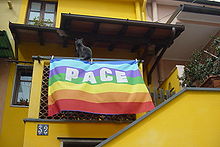
The international peace flag in the colours of the rainbow was first used in Italy on a 1961 peace march fromPerugiatoAssisiorganized by the pacifist and social philosopherAldo Capitini(1899–1968). Inspired by the peace flags used on British peace marches, Capitini got some women of Perugia hurriedly to sew together coloured strips of material.[74]The march has been repeated many times since 1961, including in 2010.[75]The original flag was kept by Capitini's collaborator, Lanfranco Mencaroni, at Collevalenza, nearTodi.[74]In 2011, plans were announced to transfer it to thePalazzo dei Prioriin Perugia.[76]
The flag commonly has sevenrainbow-colored stripes with the word PACE (Italianfor "peace" ) in the center. It has been explained as follows:
In the account of the Great Flood, God set the rainbow to a seal the alliance with man and nature, promising that there will never be another Flood. The rainbow thus became a symbol of Peace across the earth and the sky, and, by extension, among all men.[74]
The flag usually has the colours violet, indigo, blue, green, yellow, orange and red from top to bottom, but some have the violet stripe below the blue one (as in the picture at the right) or a white one at the top.[77]A picture of Capitini's first peace flag, carried by Anna Capitini and Silvana Mencaroni, shows the colours red, orange, white, green, violet, indigo, and lavender.[74]
In 2002, renewed display of the flag was widespread with thePace da tutti i balconi( "Peace from every balcony" ) campaign, a protest against the impendingwar in Iraqplanned by the United States and its allies. In 2003, the Italian newspaperCorriere della Serareported leading advertising executives saying that the peace flag had become more popular than the Italian national flag.[78]In November 2009, a huge peace flag, 21m wide by 40m long, was made inLecce,Salento,by young members of "GPACE – Youth for Peace – Give Peace a Chance Everywhere".[79]
Predator and prey lie down together
[edit]
The imagery of a predator and prey lying down together in peace is depicted in the Bible:
The wolf will live with the lamb, the leopard will lie down with the goat, the calf and the lion and the yearling together; and a little child will lead them.
— Isaiah 11:6
One of the first coins to be minted was thecroeseid.It depicted the Lydian Lion and Hellenic Bull, representing the peaceful alliance betweenCroesusand the dynasty ofAgamemnonenthroned inCyme.This alliance had been sealed through two royal marriages,Hermodike Ic. 800 BC[80]to the Phrygian kingMidasandHermodike IIc. 600 BC[81]toAlyattes of Lydia.Alyattes was Croesus' father and Hermodike II was likely his mother. When he came to power, Croesus minted the first coin depicting two animals. The roaring lion – symbol ofLydia– and the bull – symbol of HellenicZeus[82](from theSeduction of Europa[83]) – are facing each other in truce; Note that hunting lions attack from the rear, not face-to the horns. The imagery of a predator and prey lying down together in peace is reflected in other ancient literature, e.g. "...the calf and the lion and the yearling together..."c. 700 BC(Isaiah 11:6, see above). The croeseid symbolism of peace between the Greeks of Asia Minor, Lydians and laterPersians(underCyrus the Great) persisted long after Croesus' death – untilDarius the Greatintroduced new coinsc. 500 BC.[citation needed]
The union ofPhrygiaandLydiawithAeolian Greeksresulted in regional peace, which facilitated the transfer of ground-breaking technological skills into Ancient Greece; respectively, thephonetic written script[dubious–discuss]and the minting ofcoinage(to use a token currency, where the value is guaranteed by the state).[84]Both inventions were rapidly adopted by surrounding nations through further trade and cooperation and have been of fundamental benefit to the progress of civilization.[citation needed]
V sign
[edit]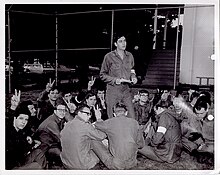
TheV sign(U+270C✌VICTORY HANDinUnicode) is ahand gesture,palm outwards, with the index and middle fingers open and all others closed. It had been used to represent victory during the Second World War.[85]During the 1960s in the US, activists against theVietnam Warand in subsequent anti-war protests adopted the gesture as a sign of peace.[86]
Paper cranes
[edit]
Thecrane,a traditional symbol of luck in Japan, was popularized as a peace symbol by the story ofSadako Sasaki(1943–1955), a girl who died as a result of theatomic bombexploding overHiroshimain 1945. According to the story, popularized through the bookSadako and the Thousand Paper Cranes,[87]in the last stages of her illness she started folding paper cranes, inspired by the Japanese saying that one who folded athousand origami craneswas granted a wish. This made an impression in people's minds. As a result, she is remembered on every 6 August, which is an annual peace day for people all over Japan.[citation needed]

Japanese Peace Bell
[edit]
TheJapanese Peace Bellis a United Nations peace symbol. Cast on 24 November 1952, it was an official gift of the Japanese people to the United Nations on 8 June 1954. The symbolic bell of peace was donated by Japan to the United Nations at a time when Japan had not yet been officially admitted to the United Nations. The Japanese Peace Bell was presented to the United Nations by the United Nations Association of Japan.[88]
Shalom/salaam
[edit]Awordmarkof the three words,Hebrewwordshalom(Hebrew:שָׁלוֹם), together with theArabicsalaam(Arabic:سلام) and the English wordpeacehas been used as a peace symbol in the Middle East.Shalomandsalaammean'peace'and arecognatesof each other, derived from theSemitictriconsonantalofS-L-M(realized in Hebrew asŠ-L-Mand in Arabic asS-L-M). The symbol has come to representpeace in the Middle Eastand an end to theArab–Israeli conflict.Wall plaques, signs, T-shirts, and buttons are sold with only those words.[89]
See also
[edit]- White-blue-white flag,Russian anti-war flag
- Green ribbon,Russian anti-war symbol
- Earth anthems,songs celebrating or eulogizing the world
Notes
[edit]- ^in the painting, the peasant shown has his arms stretched upwards, not downwards.
References
[edit]- ^ab"The CND symbol".Cnduk.org. 22 January 2014.Archivedfrom the original on 24 July 2011.
- ^abBreyer, Melissa (21 September 2010)."Where did the peace sign come from?".Shine.Yahoo!.Archivedfrom the original on 7 November 2012.Retrieved30 September2010.
- ^"History of the Symbol".Campaign for Nuclear Disarmament.Archivedfrom the original on 26 July 2018.Retrieved8 May2019.
- ^Rupert Graves,The Greek Myths,Harmonsdsworth: Penguin Books, 1962, Section 53.7
- ^"Theoi Greek Mythology".Theoi.com.Archivedfrom the original on 22 February 2012.Retrieved21 February2012.
- ^"Coins of Roman Egypt".Coins of Roman Egypt.Archivedfrom the original on 13 March 2012.Retrieved21 February2012.
- ^Virgil,Georgics,2, pp.425ff (trans. Fairclough)
- ^abcd"Great Seal".Great Seal.Retrieved21 February2012.
- ^Ragnar Hedlund, "Coinage and authority in the Roman empire, c. AD 260–295",Studia Numismatica Upsaliensia,5, University of Uppsala, 2008
- ^abJames Elmes,A General and Bibliographical Dictionary of the Fine Arts,LondonArchived10 April 2023 at theWayback Machine:Thomas Tegg,1826Elmes, James (1826)."A General and Bibliographical Dictionary of the Fine Arts: Containing Explanations of the Principal Terms Used in the Arts of Painting, Sculpture, Architecture, and Engraving, in All Their Various Branches; Historical Sketches of the Rise and Progress of Their Different Schools; Descriptive Accounts of the Best Books and Treatises on the Fine Arts; and Every Useful Topic Connected Therewith".Archived from the original on 10 April 2023.Retrieved30 September2010.
{{cite web}}:CS1 maint: bot: original URL status unknown (link) - ^Appian of Alexandria."Appian's History of Rome: The Spanish Wars (§§91–95)".Livius.org.Archivedfrom the original on 13 January 2012.Retrieved21 February2012.
- ^Nathaniel Hooke,The Roman history: From the Building of Rome to the Ruin of the Commonwealth,London: J. Rivington, 1823Archived20 February 2018 at theWayback Machine
- ^Anselment, Raymond A. (1988).A. Anselment,Loyalist resolve: patient fortitude in the English Civil War,Associated University Presses, 1988.ISBN9780874133387.Archivedfrom the original on 19 June 2013.Retrieved21 February2012.
- ^"Coins of Quality: The art of Coins".Petitioncrown.com.Archivedfrom the original on 15 February 2012.Retrieved21 February2012.
- ^Old Naval CollegeArchived26 June 2007 at theWayback Machine
- ^"Catholic Encyclopedia,Roman Catacombs: Paintings ".Newadvent.org. 1 November 1908.Archivedfrom the original on 11 January 2012.Retrieved21 February2012.
- ^Mt 3:16
- ^"'Catholic Encyclopedia' Dove: As an artistic symbol ".Newadvent.org. 1 May 1909.Archivedfrom the original on 6 February 2012.Retrieved21 February2012.
- ^The Early Christian World,Volume 1, p. 148,Philip Esler
- ^1Pt 3:20–21
- ^Hall, Christopher A. (2010) [2009].Worshipping with the Church Fathers.InerVarsity Press. p. 32.ISBN9780830838660.Archivedfrom the original on 16 June 2013.Retrieved21 February2012.
- ^"... praeco columba terris adnuntiavit dimissa ex arca et cum olea reversa – quod signum etiam ad nationes pacis praetenditur eadem dispositione spiritalis effectus terrae..."Tertullian,On Baptism,Chapter 8Archived24 December 2016 at theWayback Machine
- ^abcGraydon D. Snyder,Ante Pacem: archaeological evidence of church life before Constantine,Macon: Mercer University Press, 2003
- ^"John Dominic Crossan,Inventory of Biblical Scenes on Pre-Constantinian Christian Art".Faculty.maryvillecollege.edu. Archived fromthe originalon 25 March 2012.Retrieved21 February2012.
- ^"Bene Merenti – Inscriptions from the Roman Catacombs".Usask.ca.Archivedfrom the original on 10 January 2012.Retrieved21 February2012.
- ^"David Salmoni".Archivedfrom the original on 14 March 2012.Retrieved21 February2012.
- ^Babelon, Ernest Charles François (1911)..InChisholm, Hugh(ed.).Encyclopædia Britannica.Vol. 12 (11th ed.). Cambridge University Press. pp. 802–803, see page 803.
In these catacombs we find numerous sarcophagi and inscriptions painted or engraved of the Roman and Byzantine periods
- ^"Where the stones cry out".The Moslem World.October 1922.Retrieved21 February2012.
- ^"The Sousse Catacombs".Patrimoinedetunisie.com.tn.Archivedfrom the original on 18 January 2012.Retrieved21 February2012.
- ^Graydon F. Snyder, "The Interaction of Jews with Non-Jews in Rome", in Karl P. Donfreid and Peter Richardson,Judaism and Christianity in Early Rome,Grand Rapids: Wm B. Ferdman, 1998
- ^Gen 8:11
- ^[1]Genesis Rabbah33:6'
- ^"Babylonian Talmud Sanhedrin 108b".Halakhah.com.Archivedfrom the original on 3 February 2012.Retrieved21 February2012.
- ^"Eruvin 18b"(PDF).Archived(PDF)from the original on 2 February 2012.Retrieved21 February2012.
- ^"Rashi".Tachash.org. Archived fromthe originalon 19 August 2018.Retrieved21 February2012.
- ^"Peace Sign – Meaning And A Brief History In 2021".Archivedfrom the original on 20 September 2021.Retrieved20 September2021.
- ^Augustine of Hippo, 'On Christian Doctrine'.1883.ISBN9781593774943.Archivedfrom the original on 19 June 2013.Retrieved21 February2012.
- ^"British Library,The Holkham Bible".Bl.uk. 30 November 2003.Archivedfrom the original on 7 February 2012.Retrieved21 February2012.
- ^"Wycliffe Bible, Gen 8:11".Studylight.org.Archivedfrom the original on 2 February 2012.Retrieved21 February2012.
- ^British Library, "Golden Haggadah"Archived6 August 2016 at theWayback Machine
- ^Narkiss, Bezalel,The Golden Haggadah,London: The British Library, 1997, p. 22
- ^British Library, Online Gallery, Sacred Texts.Archived14 August 2011 at theWayback MachineThe Golden Haggadah,p.3, lower left hand panel.
- ^Mattingly, Gareth, "Michiavelli", in Plumb, J.H.,The Horizon Book of the Renaissance,London: Collins, 1961
- ^""Commission and instruction to Niccolo Machiavelli, Sent to Sienna by the Ten of Liberty and Peace", in Niccolo Machiavelli,The Historical, Political, and Diplomatic Writings,vol. 3 (Diplomatic Missions 1498–1505) ".Oll.libertyfund.org.Archivedfrom the original on 24 October 2012.Retrieved21 February2012.
- ^"Santi, Rainer,100 years of peace making: A history of the International Peace Bureau and other international peace movement organisations and networks,Pax förlag, International Peace Bureau, January 1991 ".Santibox.ch.Archivedfrom the original on 21 April 2012.Retrieved21 February2012.
- ^"Museum of Modern Art".Moma.org. 9 January 1949.Archivedfrom the original on 12 October 2011.Retrieved21 February2012.
- ^"Tate Gallery".Tate.org.uk.Archivedfrom the original on 13 January 2012.Retrieved21 February2012.
- ^"BBC Modern Masters".BBC.Archivedfrom the original on 14 April 2012.Retrieved21 February2012.
- ^"Princeton University Library".Infoshare1.princeton.edu.Archivedfrom the original on 18 March 2012.Retrieved21 February2012.
- ^Bill Hetheringon,Symbols of Peace, Housmans Peace Diary 2007,' London: Housmans, 2006
- ^ab"Margaret Llewelyn Davies (1861–1943) and Emmy Freundlich (1878–1948)".Women of Conviction.Hull Women's Archives.Archivedfrom the original on 12 October 2008.
- ^"Pact and Banner Of Peace Through Culture"Archived16 March 2013 at theWayback Machine,Nicholas Roerich Museum, New York
- ^ab"Nuclear Disarmament Symbol Drawings".The Peace Museum's Collection.The Peace Museum, Bradford. Archived fromthe originalon 1 February 2014."
- ^Jack, Ian (28 November 2015)."He gave his unforgettable work for nothing. Shouldn't the designer of the peace symbol be commemorated?".The Guardian.Archivedfrom the original on 20 February 2018.Retrieved20 February2018.
- ^"First use of the peace symbol, 1958".Archived fromthe originalon 19 February 2012.Retrieved21 February2012.
- ^Lacayo, Richard (27 March 2008)."A Piece of Our Time".Time Magazine.Archived fromthe originalon 1 April 2008.Retrieved2 April2008.
- ^abcdChristopher Driver,The Disarmers: A Study in Protest,London: Hodder and Stoughton, 1964.
- ^W. J. Mc Cormack (17 July 1999)."Obituary of Eric Austen,The Independent,17 July 1998 ".The Independent.UK.Archivedfrom the original on 22 January 2012.Retrieved21 February2012.
- ^"On February 21, 1958, the Peace Symbol Design Was Completed by Gerald Holtom".vintag.es.Vintage Everyday. 21 February 2022.Archivedfrom the original on 21 February 2022.Retrieved20 March2022.
- ^"Early Defections in March",Manchester Guardian,5 April 1958Archived22 November 2016 at theWayback Machine"By the time the marchers had left Chiswick they numbered less than two thousand. Above them bobbed the signs of the Campaign for Nuclear Disarmament, a sort of formalised white butterfly which, it appeared, was the semaphore sign for" N.D. ""
- ^"The CND symbol".Hugh Brock Papers.Archivedfrom the original on 3 October 2013.
- ^"History of the Symbol".Campaign for Nuclear Disarmament.Archivedfrom the original on 26 July 2018.Retrieved8 May2019.
- ^Westcott, Kathryn (20 March 2008)."World's best-known protest symbol turns 50".BBC News.Archivedfrom the original on 21 March 2008.Retrieved20 March2008.
- ^Lawrence S Wittner (1993).The Struggle Against the Bomb: Volume Two, Resisting the Bomb: A History of the World Nuclear Disarmament Movement.Stanford University Press. p. 55.ISBN9780804729185.Archivedfrom the original on 16 June 2013.Retrieved24 July2009.
- ^Ken Kolsbun with Mike Sweeney (1 April 2008).Peace: The Biography of a Symbol.National GeographicBooks.ISBN978-1-4262-0294-0.Retrieved28 August2008.
- ^George Stanford,The Myth of the Witch's Foot: How the John Birch Society Created a Hoax About the Peace Sign,Monday, 3 December 2012Archived17 October 2015 at theWayback Machine
- ^"The Morning Record,Meriden, Conn, 22 Oct 1970, p.29 ".Archivedfrom the original on 11 April 2016.Retrieved18 March2016.
- ^"World's best-known protest symbol turns 50"Archived20 March 2012 at theWayback Machine.BBC News Magazine,20 March 2008
- ^"The CND logo".Campaign for Nuclear Disarmament.Archivedfrom the original on 25 March 2008.Retrieved3 April2008.
- ^"In the past, a very similar inverted cross was known to represent Peter hanging upside down on the cross. When that symbol was placed on the door, it was a sign to persecuted Christians that there would be church services in that home." PasadenaStar-News8 May 1968, cited afterGeorge Stanford,The Myth of the Witch's Foot: How the John Birch Society Created a Hoax About the Peace SignArchived17 October 2015 at theWayback Machine,Monday, 3 December 2012.
- ^Walling, Marie H. (13 January 1969)."Popular pendant's meaning: symbol of peace or evil?".Arizona Republic.p. 41.Retrieved21 March2024– viaNewspapers.com.
- ^National Republican Congressional Committee (28 September 1970), cited after Stanford (2012). Caption Wochenspruch der NSDAP. / Herausgeber / Folge 12, 15. – 21. MarzWochenspruchFolge 12, 15–21 März,Reichspropagandaleitung der NSDAP (1942).
- ^"What's in a Symbol?"Archived30 October 2010 at theWayback Machine,Time,2 November 1970.
- ^abcdThe Story of the Peace FlagArchived3 March 2016 at theWayback Machine(Italian)
- ^""The Perugia-Assisi Peace March", Paolo Andruciolli,rassegna.it,14 May 2010 (Italian) "(in Italian). Rassegna.it.Archivedfrom the original on 15 March 2012.Retrieved21 February2012.
- ^Perugia TodayArchived26 June 2015 at theWayback Machine(In Italian)
- ^"Pace Oggi (Peace Today) (Italian)".Scuoleingioco.it. Archived fromthe originalon 19 January 2012.Retrieved21 February2012.
- ^RCS Corriere della Sera.""Bandiera della pace più popolare del tricolore",Corriere della Sera,20 February 2003 (Italian) ".Corriere della Sera(in Italian).Archivedfrom the original on 13 January 2012.Retrieved21 February2012.
- ^[dead link]"Youth for Peace".GPACE.Archivedfrom the original on 1 March 2012.Retrieved21 February2012.
- ^The Cambridge Ancient History, edited by John Boederman, Cambridge University Press, 1997, p. 832
- ^Mycenaean Origin of Greek Mythology, Martin Nilsson, 1983 Univ of California Press, p. 48.
- ^Perseus 1:2.7Archived31 December 2022 at theWayback Machine:"[Hercules] had Agelaus, from whom the family of Croesus was descended."
- ^Grimal, Pierre, (1991).The Penguin Dictionary of Classical Mythology.Kershaw, Stephen. ([Abridged ed.] ed.). London, England: Penguin Books.ISBN0140512357.OCLC 25246340.
- ^Amelia Dowler, Curator, British Museum; A History of the World;http://www.bbc.co.uk/ahistoryoftheworld/objects/7cEz771FSeOLptGIElaquAArchived22 January 2010 at theWayback Machine
- ^"Archived copy"(PDF).Archived(PDF)from the original on 15 October 2016.Retrieved15 October2017.
{{cite web}}:CS1 maint: archived copy as title (link) - ^"The Japanese Version (the Sign of Peace)"Archived21 June 2008 at theWayback Machine,Icons website. Retrieved 29 July 2007
- ^Eleanor Coerr,Sadako and the Thousand Paper Cranes,1977
- ^"7 things you didn't know about the Peace Bell".ONE.21 September 2018.Archivedfrom the original on 14 September 2021.Retrieved14 September2021.
- ^the music band called 'emma's revolution'."Online retail page for the music band called 'emma's revolution'".Archived fromthe originalon 4 July 2008.Retrieved30 December2010.
External links
[edit]- The Peace Flag
- Peace Sign
- A Circle and Three Lines
- The biography of the Peace Symbol by Ken Kolsbun
- The Hoax of the Witch's foot: How the John Birch Society created a myth about the peace sign
- Happy Birthday Peace – celebrating 50 years of Gerald Holtom's peace symbol
- World's best-known protest symbol turns 50
- What is the origin of the peace symbol?
- Unveiling of "Peace & Harmony", European Peace Monument – Dedicated to John Lennon
- A British Museum expert's view of the CND badge
- The Different Peace Flags of Pisa






